|
Testimonials, Case Studies
and Research
 Testimonials
Testimonials
 Case Studies
Case Studies
 Research
Research
 |
“It
was really great getting to meet with you and brainstorm
directory solutions. I was impressed with your knowledge
about the issues and challenges of managing a large,
online membership directory for referrals and your
technological expertise. I am very interested in working
with you on solutions for [our organization]” |
 |
“This is
pretty amazing! I am going to forward this so she can
have a sneak preview but this is awesome!!”
|
 |
“Thanks
so much!.. I appreciate all your work!”
|
 |
“This is
looking great, especially with the revised graphics.”
|
 |
“You
guys are the best. Thank you!”
|
 |
“Thanks
for sticking with it and coming up with nimble
solutions!”
|
 |
“We are
making great use of our directory!”
|
 |
“Thanks
for all of your great work on this directory!”
|
 |
“Very
slick – thanks so much for your efforts here!”
|
 |
“The
directory continues to be well received here.”
|
 |
“Great
job on pulling this together! I really appreciate you
pushing through and executing on a great directory in
spite of the staffing challenges we have had here with
[M's] departure. This turned out fantastic; the CD is
going to be a hot commodity at the show next week. Great
work!”
|
 |
“This
[metrics showing strong directory usage] is great –
thanks!”
|
 |
“Hi –
thanks for your efforts in making this [release of the
directory] happen for today (Happy July 4th, by the
way!)” |
University
of Washington Medicine Clinical Referral Directory
As part of their ongoing efforts to improve communication and
referral flow for their providers, since the end of 2011 UW
Medicine has been publishing their Clinical Referral Directory &
Guide online, on mobile apps, and on self-updating CDs & USBs
achieving the following results:

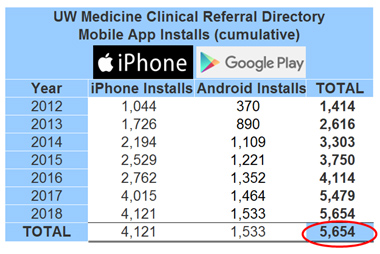
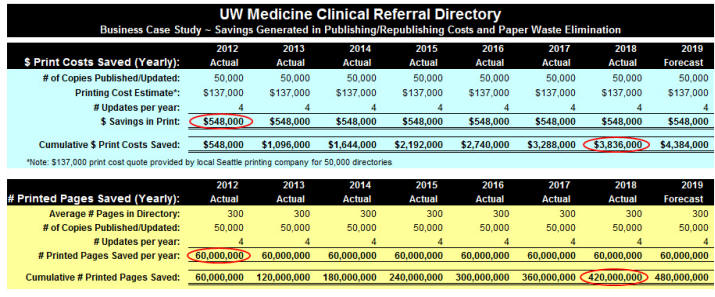
Business Case Analysis Highlights:
A/ Increasing Audience Reach and Record Usage:
 More people are using the directory than ever before, online website
usage in record numbers: 3X (338%) growth in average number
of sessions over the last three years, and about 10X (958%) growth
over the last five years.
More people are using the directory than ever before, online website
usage in record numbers: 3X (338%) growth in average number
of sessions over the last three years, and about 10X (958%) growth
over the last five years.
 Similar usage increase in the number of users, with 3X (341%) growth
over the last three years, and about 10X (977%) growth over the last
five. You can see the steady usage increase in the above graph.
Similar usage increase in the number of users, with 3X (341%) growth
over the last three years, and about 10X (977%) growth over the last
five. You can see the steady usage increase in the above graph.
 More people are using mobile apps: We are seeing 4X ie over 400%
growth in smartphone mobile app installs since 2012, for iPhones and
Android devices, from 1,414 installs to 5,654 installs at end of
2018. Figures do not include upgrades or number of sessions per
user, only new installs. We also are only reporting on US & Canada
to get the truest sense of real usage, leaving out downloads
occurring in Asia and other countries.
More people are using mobile apps: We are seeing 4X ie over 400%
growth in smartphone mobile app installs since 2012, for iPhones and
Android devices, from 1,414 installs to 5,654 installs at end of
2018. Figures do not include upgrades or number of sessions per
user, only new installs. We also are only reporting on US & Canada
to get the truest sense of real usage, leaving out downloads
occurring in Asia and other countries.
B/ Savings Generated in Publishing/Republishing Costs:
 Each year, the equivalent of $548,000 i.e. over half a million
dollars of value in cost savings is being generated.
Each year, the equivalent of $548,000 i.e. over half a million
dollars of value in cost savings is being generated.
 By the end of 2018, the cumulative value in cost savings generated
surpassed $3.8 million.
By the end of 2018, the cumulative value in cost savings generated
surpassed $3.8 million.
 By the end of 2019, this number will surpass $4.4 million in savings
which will have been generated over a seven-year time span.
By the end of 2019, this number will surpass $4.4 million in savings
which will have been generated over a seven-year time span.
C/ Paper Waste Elimination:
 Each year, 60 million of color printed pages are being saved from
going to waste.
Each year, 60 million of color printed pages are being saved from
going to waste.
 By end of 2018, the cumulative number of printed pages saved reached
420 million.
By end of 2018, the cumulative number of printed pages saved reached
420 million.
 By end of 2019, this number will become 480 million in pages saved
from going to waste over a eight-year time span.
By end of 2019, this number will become 480 million in pages saved
from going to waste over a eight-year time span.
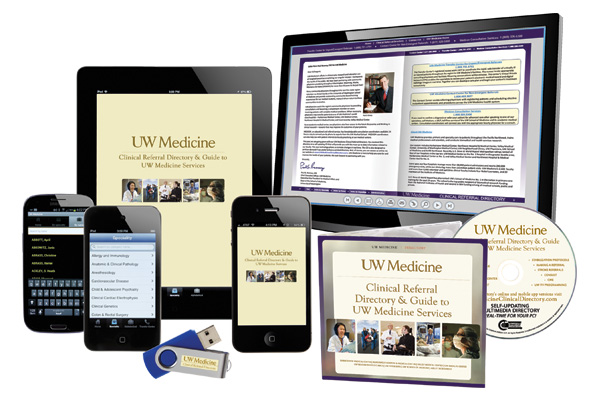
Internet
use over time:
When Americans’ internet usage started getting tracked in early
2000, about half of all adults were already online. Today,
roughly nine-in-ten American adults use the internet.
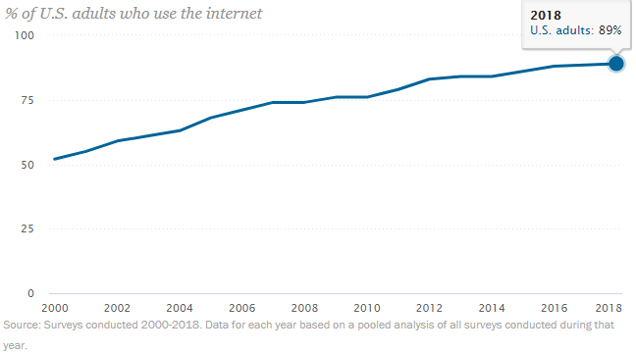
Mobile
phone ownership over time:
The vast majority of Americans – 95% – now own a cellphone of
some kind. The share of Americans that own smartphones is now
77%, up from just 35% in Pew Research Center’s first survey of
smartphone ownership conducted in 2011.
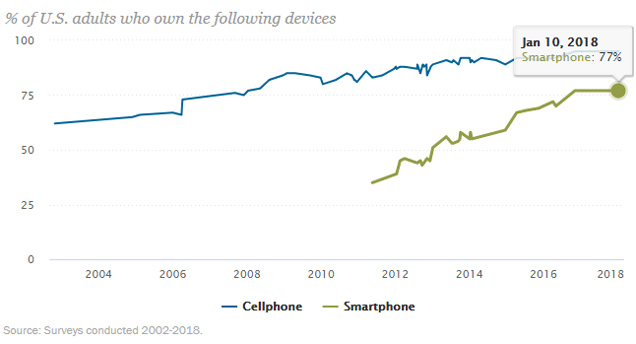
Exclusive
smartphone dependency over time:
As the adoption of traditional broadband service has slowed in
recent years, a growing share of Americans now use smartphones
as their primary means of online access at home. Today
one-in-five American adults are “smartphone-only” internet users
– meaning they own a smartphone, but do not have traditional
home broadband service.
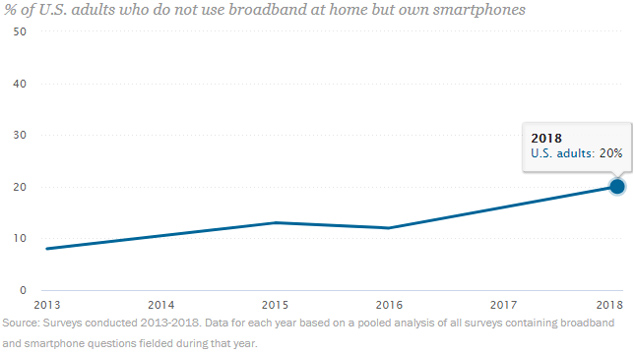
Ownership
of other devices:
Along with mobile phones, Americans own a range of other
information devices. Nearly three quarters of U.S. adults now
own desktop or laptop computers, while roughly half now own
tablet computers and around one-in-five own e-reader devices.
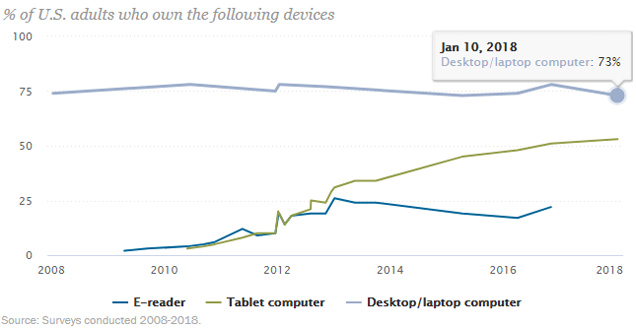
Tech
Adoption Climbs Among Older Adults:
Roughly two-thirds of those ages 65 and older go online and a
record share now own smartphones – although many seniors remain
relatively divorced from digital life.
A record 46 million seniors live in the United States today,
and older Americans – those age 65 and older – now account
for 15% of the overall U.S. population. By 2050, 22% of
Americans will be 65 and older, according to U.S. Census
Bureau projections.
At the same time America is graying, recent Pew Research
Center surveys find that seniors are also moving towards
more digitally connected lives. Around four-in-ten (42%)
adults ages 65 and older now report owning smartphones, up
from just 18% in 2013. Internet use and home broadband
adoption among this group have also risen substantially.
Today, 67% of seniors use the internet – a
55-percentage-point increase in just under two decades. And
for the first time, half of older Americans now have
broadband at home.
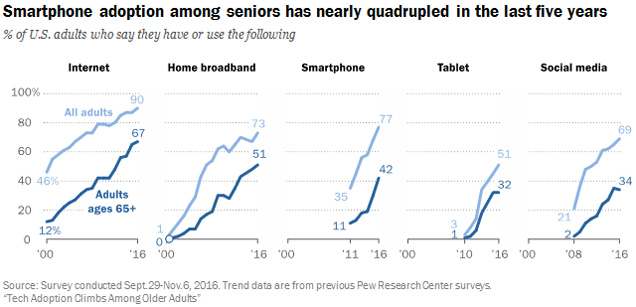
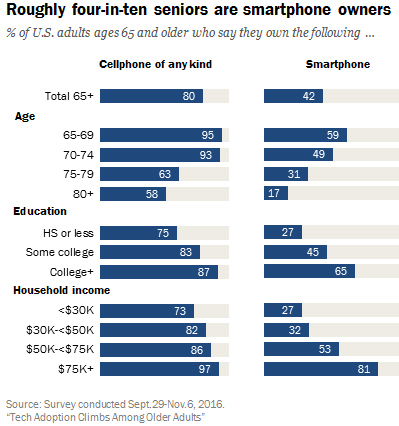
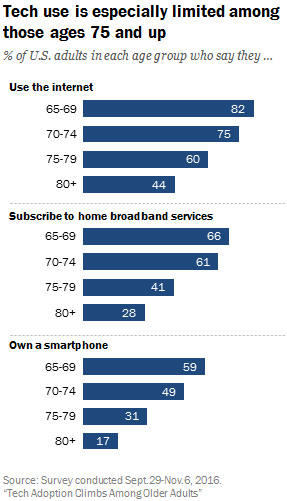

Questions?
Call
(800) 605-1782
or email
info@imaginemediapartners.com
for more information and a live online demo meeting.
|